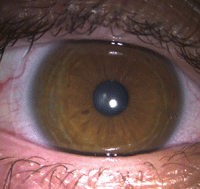 For our irregular cornea patients fitted with GP lenses, the vast majority of their days spent wearing GP lenses are characterized by good vision and acceptable comfort.
For our irregular cornea patients fitted with GP lenses, the vast majority of their days spent wearing GP lenses are characterized by good vision and acceptable comfort.
However, many of those same patients will have a day every now and then when their eyes are particularly intolerant of their lenses. Whether due to dryness, epithelial erosion or other causes, the sensitivity and irritation they will occasionally feel is bad enough to make them have to take a brief respite from GP lens wear, at least in one eye.
Switching to glasses for the day is, unfortunately, not a good option, in that many of these individuals cannot easily wear spectacle lenses due to their unique refractive correction or lack reasonable best-corrected vision with those lenses. This leaves them with compromised vision.
The advent of a number of new and improved soft lenses for irregular corneas has allowed many individuals who could not succeed with GPs to move into soft lenses, thus improving their ocular comfort and ability to wear contact lenses more of their waking hours.
While these lenses do not always provide the same quality of visual correction as a GP lens, they often do come reasonably close; for many patients, it is an acceptable trade-off.
Case Report
JR, a 39-year-old male with a history of keratoconus in both eyes, first presented to my office three years ago after moving to the area. Two years prior to his first visit to my office, he had Intacs corneal implants and corneal collagen crosslinking performed, with no complications.
He was wearing piggyback soft disposable lenses with intralimbal corneal GP lenses in each eye during work hours, and had a pair of soft keratoconic-designed lenses that he switched to in the evenings and at times on the weekends for entire days. His chief complaint was a desire to upgrade his soft lenses. He stated that his piggyback lenses were working well.

Flexlens Tricurve soft on a patient who uses corneal GP lenses during work hours. Vision is 20/25 and comfort is 10/10.
A complete exam was performed as well as assessment of both his piggyback lenses and soft lenses. All results were unremarkable other than the expected findings related to keratoconus and Intacs. His piggyback lens fit was excellent and his vision was good with no substantial over-refraction.
His soft lenses were evaluated and did fit well, but his vision was reduced to 20/60 and 20/40 with them. These lenses were over one year old, and he was interested in what newer technology was available. I told him there were new lens designs that used more oxygen permeable materials; he was interested in trying them.
A refitting into Kerasoft IC lenses was performed. The final lens parameters were:
OD: BC – 8.6 / -2.50 -2.25 x 60 / 14.5 / Steep 2 / 20/20-2
OS: BC – 8.6 / -5.75 / 14.5 / Steep 2 / 20/25
JR was happy with the comfort and the noticeably improved acuity. He continued to use these lenses as a part-time mode over the next year, and has used the same basic lens fit and parameters now for nearly three years.
Hard Problems, Soft Solutions
This case was one that opened my eyes to a new way of of addressing my GP lens patients. Prior to this patient encounter, the concept of prescribing soft specialty contact lenses as a back-up to GP lenses had never really occurred to me, nor had I ever seen it successfully done.
Since this encounter, I have discussed the option with most of my keratoconus patients who feel they cannot rely on glasses as an acceptable back-up to contact lens wear. Nearly half of those individuals have been receptive and opt for a pair of soft lenses as an alternative means of correction to their GPs.
The benefits of this strategy are many. First, the wearer has the option of giving the eyes a planned hiatus from GPs to maintain the best comfort the other days of the week. Second, it gives them the ability to choose these lenses for wear during times of high physical activity, as they may be more stable than GPs in such scenarios.
Third, on days when the GPs seem to bother an eye more than usual, a soft lens may be better tolerated, allowing the individual to have their vision corrected that day rather than foregoing a lens altogether and experiencing poor vision.
Surely the evolution of scleral lenses may, to some, make this option seem less useful. I would only relate that I have some scleral lens wearers who enjoy their soft lens option from time to time just as corneal GP wearers do.
Others might feel that the cost is prohibitive to have multiple pair of lenses but, compared to the cost of glasses—particularly with the prescriptions needed for many of these patients—it really should not be.
As this column focuses on GP-related strategies, it may seem counterintuitive to contemplate specialty soft lens fitting options. However, this approach allows us to help our GP patients enjoy and get more mileage out of their GP lenses, not simply promote soft lenses.
For GP lens wearers with irregular corneas and complaints of intermittent lens intolerance, consider a soft lens alternative.


